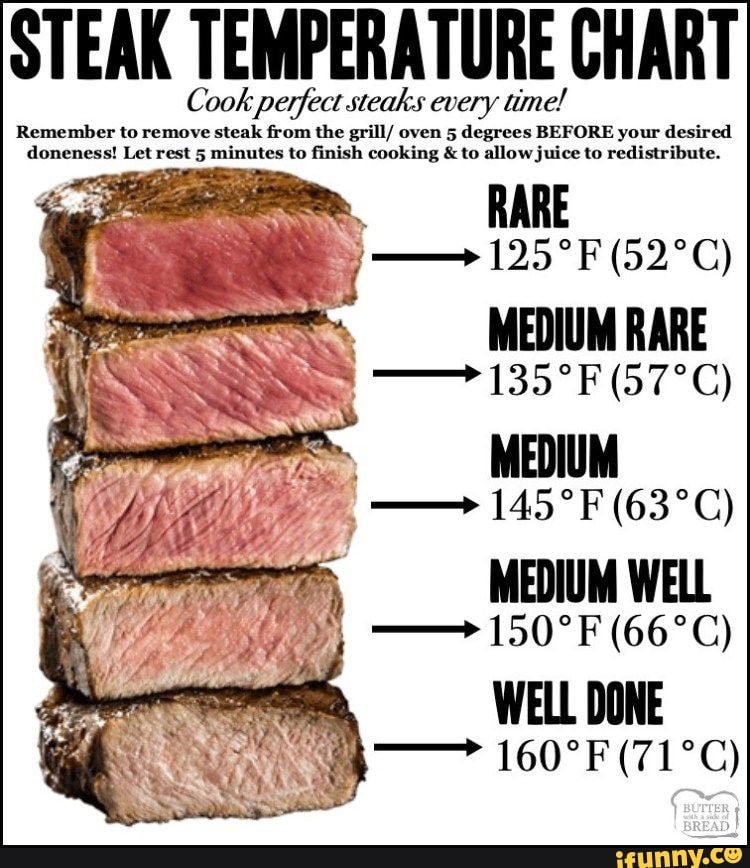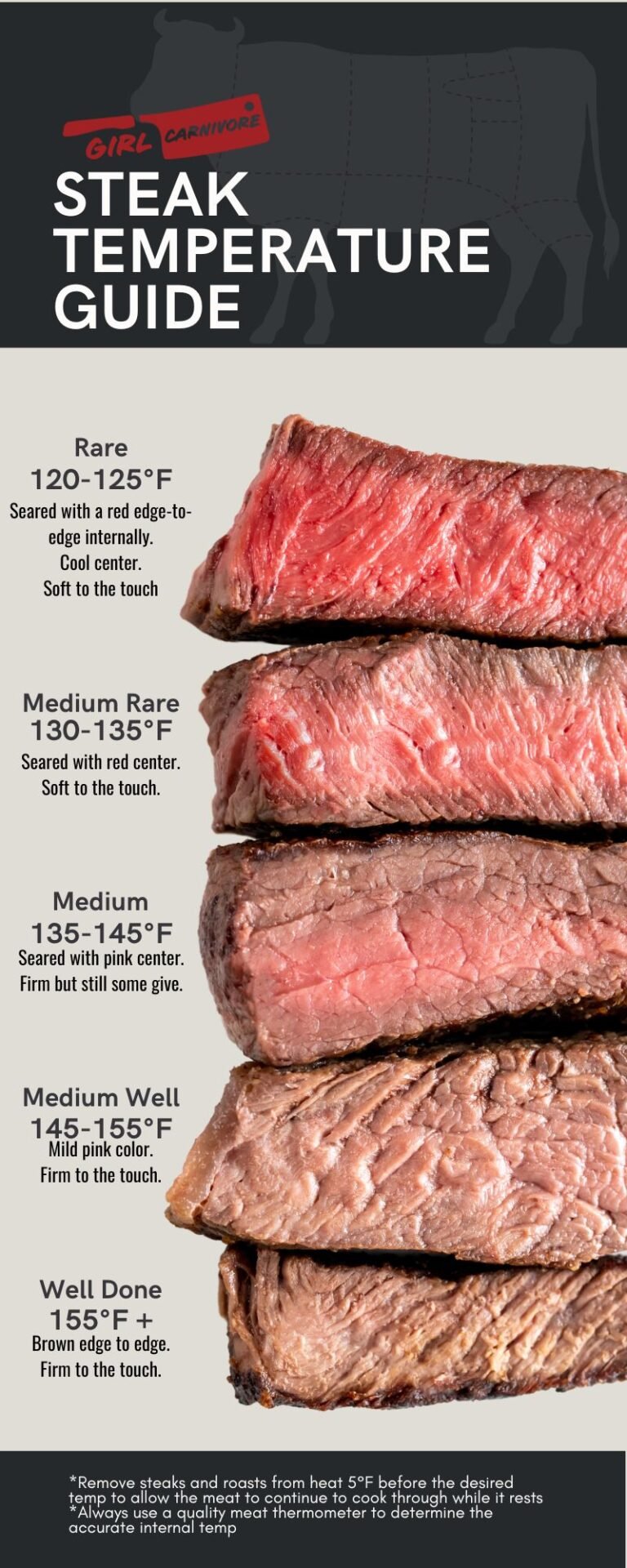Steak Doneness Guide: Temp & How To Cook It PERFECTLY!
Are you ready to unlock the secrets to a perfectly cooked steak, every single time? Mastering the art of steak doneness is easier than you think, and the key lies in understanding internal temperatures.
Forget guesswork and inconsistent results. With a reliable meat thermometer and a little know-how, you can confidently cook steak to your exact preference, whether it's a melt-in-your-mouth rare, a juicy medium-rare, or a well-done masterpiece. This guide provides everything you need to achieve steak perfection, from understanding internal temperatures to recognizing visual cues for each level of doneness.
| Topic | Description |
|---|---|
| What is Medium Rare | Medium rare steak is cooked to a perfect temperature where the inside is warm red and outside edge is little browned. |
| Temperature for Medium Rare | Temperature for medium rare lies between 130F to 135F. |
| Why Medium Rare Steak is Best | Medium Rare steak renders and adds buttery and rich flavors to the steak which makes it juicy and flavorful. |
| Certified Angus Beef |
The culinary landscape is vast and varied, but few dishes evoke the primal satisfaction of a perfectly cooked steak. Its a centerpiece meal, a celebratory indulgence, and a testament to the skill of the cook. But achieving that perfect doneness the sweet spot between raw and overcooked can often feel like a high-stakes gamble. The good news is, it doesnt have to be. The secret weapon in your steak-cooking arsenal is a simple, yet powerful tool: the meat thermometer. Armed with this device and an understanding of internal temperatures, you can transform from a nervous novice to a confident steak aficionado.
- Tausha Kutcher Ashton Kutchers Sister Life Career Family
- Ultimate Steak Doneness Guide Temp Thermometer Tips
Let's delve into the specifics of internal temperatures and their corresponding levels of doneness. This is your roadmap to steak nirvana. Understanding these temperatures is paramount to achieving the desired texture and flavor profile.
Rare: This is for those who prefer a minimal amount of cooking. A rare steak will have a bright red center, only slightly warmed through. The internal temperature should reach 125F (52C). Be aware that some culinary experts and health organizations advise against rare steak due to potential bacterial concerns.
Medium Rare: The gold standard for many steak lovers. A medium rare steak boasts a warm red center, surrounded by a generous band of pink, transitioning to browned edges. The internal temperature sweet spot is between 130F to 135F (54C to 57C). This is where the magic happens. The fat within the steak, known as marbling, begins to render, infusing the meat with a rich, buttery flavor and creating a tender, juicy texture. Medium rare is often considered the ideal balance between tenderness and flavor, making it a popular choice in restaurants and home kitchens alike.
- Candace Owens Exposes The Truth Behind Becoming Brigitte Macron
- Hubmasa Safe Platform Or Risky Website The Facts Revealed
Medium: If you prefer a slightly firmer texture, a medium steak is the way to go. The center will be a hot pink, with a more pronounced band of brown around the edges. Aim for an internal temperature of 135F to 145F (57C to 63C). While still juicy, a medium steak will have less of the pronounced "melt-in-your-mouth" quality of a medium rare.
Medium Well: As you move further along the doneness spectrum, the steak becomes increasingly firm and loses moisture. A medium well steak will have a light pink center, surrounded by a thicker ring of brown. The internal temperature should reach 145F to 155F (63C to 68C).
Well Done: A well-done steak is cooked through completely, with no pink remaining. It will be uniformly brown throughout and have a significantly firmer texture. The internal temperature should reach 155F and above (68C+). While some prefer this level of doneness, it's important to note that a well-done steak can be drier and less flavorful due to the loss of moisture during the cooking process. The USDA recommends a minimum internal temperature of 145F (63C) for beef, followed by a three-minute rest.
Now that you understand the target internal temperatures, let's discuss how to use your meat thermometer effectively. The key is to insert the thermometer into the thickest part of the steak, avoiding bone or large pockets of fat, which can give inaccurate readings. For thinner steaks (less than 1.5 inches), obtaining an accurate temperature reading can be challenging. In these cases, relying on cooking time and visual cues becomes more important.
Beyond internal temperature, visual cues can also help you determine doneness. Here's what to look for:
- Rare: Bright red center with slight char on the outside.
- Medium Rare: Warm red center with more browning on the edges.
- Medium: Light pink center with a thicker ring of brown.
- Medium Well: Very little pink remaining.
- Well Done: No pink at all.
Remember that the steak will continue to cook slightly even after it's removed from the heat. This is known as "carryover cooking." To account for this, remove the steak from the grill or pan when it's about 5-10 degrees below your target temperature. For example, if you're aiming for medium rare (130F-135F), pull the steak off the heat when it reaches around 125F to 130F. Then, let it rest for at least 5-10 minutes before slicing and serving. Resting allows the juices to redistribute throughout the steak, resulting in a more tender and flavorful final product.
The time it takes to cook a steak to your desired doneness will depend on several factors, including the thickness of the steak, the temperature of your grill or pan, and the type of steak. As a general guideline, for a 1-inch thick steak, you can use the following cooking times:
- Rare: 2-3 minutes per side
- Medium Rare: 3-4 minutes per side
- Medium: 4-5 minutes per side
- Medium Well: 5-6 minutes per side
- Well Done: 6-7 minutes per side
These times are approximate and should be adjusted based on your specific equipment and the thickness of the steak. Always use a meat thermometer to confirm the internal temperature.
Medium Rare: The Sweet Spot: It bears repeating: medium rare is often hailed as the pinnacle of steak perfection. The balance of tenderness and flavor is simply unmatched. The rendering fat creates a buttery richness that elevates the steak to another level. It's no surprise that medium rare is the most popular choice in restaurants and among discerning home cooks.
Don't Overcook: While personal preference is paramount, it's important to avoid overcooking steak. Overcooked steak becomes dry, tough, and loses much of its flavor. Aiming for a lower level of doneness and using a meat thermometer to monitor internal temperature is the best way to ensure a juicy, flavorful result.
Sous Vide Method: For unparalleled precision, consider the sous vide method. This involves cooking the steak in a water bath at a precise temperature, ensuring even cooking throughout. For a medium rare sous vide steak, set the water bath to 135F (57C). After sous vide cooking, sear the steak in a hot pan to develop a beautiful crust.
The Importance of Rest: Never underestimate the power of resting. After cooking, allow the steak to rest for at least 5-10 minutes before slicing. This allows the juices to redistribute, resulting in a more tender and flavorful steak.
Experiment and Refine: Cooking steak is a journey, not a destination. Experiment with different cuts of steak, cooking methods, and levels of doneness to find your perfect combination. Don't be afraid to make mistakes they are valuable learning opportunities. With practice and patience, you'll become a master of the art of steak cooking.
The Influence of Temperature on Color: As the internal temperature of the steak rises during cooking, the color of the meat undergoes a transformation. This color change provides a visual indication of the steak's doneness, though it should always be confirmed with a meat thermometer for accuracy. The progression from bright red to pink to brown reflects the coagulation of proteins and the breakdown of muscle fibers within the meat.
The Illusion of Doneness: The color of the steak's surface can be misleading, especially when cooking over high heat. A dark, charred exterior does not necessarily indicate that the steak is cooked through to the desired level of doneness. It's crucial to rely on internal temperature rather than surface appearance alone to ensure accurate cooking.
The Role of Fat: The amount of fat within the steak, known as marbling, plays a significant role in the final flavor and texture. Steaks with ample marbling, such as ribeye or New York strip, tend to be more flavorful and tender when cooked to medium rare or medium. The rendering fat infuses the meat with richness and helps to keep it moist during cooking.
Cutting Against the Grain: After resting, always slice the steak against the grain. This means cutting perpendicular to the direction of the muscle fibers. Cutting against the grain shortens the fibers, making the steak more tender and easier to chew.
Seasoning Strategies: Proper seasoning is essential for enhancing the flavor of the steak. A simple combination of salt and pepper is often sufficient, but you can also experiment with other seasonings, such as garlic powder, onion powder, or paprika. Season the steak generously on all sides before cooking.
Pan-Seared Perfection: For those without access to a grill, pan-searing is an excellent alternative. Use a heavy-bottomed skillet, such as cast iron, and heat it over high heat. Add a small amount of oil to the pan and sear the steak for 2-3 minutes per side, or until a dark crust forms. Then, reduce the heat and continue cooking to your desired doneness, using a meat thermometer to monitor the internal temperature.
Grilling Guidelines: Grilling imparts a unique smoky flavor to steak. Preheat your grill to medium-high heat. Place the steak on the grill grates and cook for the appropriate amount of time, turning once halfway through. Use a meat thermometer to ensure that the steak reaches your desired internal temperature.
Consider the Cut: Different cuts of steak have different characteristics and require different cooking techniques. Tender cuts, such as filet mignon, are best cooked quickly over high heat. Less tender cuts, such as flank steak, benefit from marinating and slow cooking.
Safe Cooking Temperatures: While some prefer rare steak, it's important to be aware of the potential risks associated with consuming undercooked meat. The USDA recommends a minimum internal temperature of 145F (63C) for beef to ensure that harmful bacteria are killed. Pregnant women, young children, and individuals with weakened immune systems should avoid consuming rare steak.
Ultimately, the best way to cook steak is the way that you enjoy it most. Experiment with different techniques, temperatures, and seasonings to find your perfect steak-cooking formula. With practice and a little bit of knowledge, you can consistently create delicious, perfectly cooked steaks that will impress your friends and family.
So, grab your meat thermometer, choose your favorite cut of steak, and embark on a culinary adventure. The world of perfectly cooked steak awaits!
Remember, mastering the art of steak doneness is about understanding internal temperatures, utilizing a reliable meat thermometer, and experimenting with different techniques to find what works best for you. With these tools and knowledge, you'll be well on your way to creating consistently delicious and perfectly cooked steaks.
The pursuit of the perfect steak is a noble one. And with the right guidance, it's a pursuit within everyone's reach. So go forth, experiment, and enjoy the journey to steak perfection.
- Vegamovies Alternatives Best Legal Streaming Platforms In 2024
- Best Ways Where To Watch Movies Online Streaming Guide More

Steak Temperature Chart (Rare, Medium Rare, Medium, Medium Well, Well Done)

STEAK TEMPERATURE CHART Cook perfect steaks every time! Remember to

Mastering Steak Temperature A Guide to Perfect Doneness Girl Carnivore